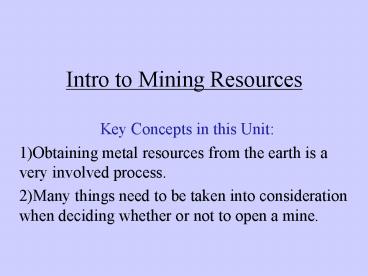Intro to Mining Resources - PowerPoint PPT Presentation
1 / 20
Title:
Intro to Mining Resources
Description:
This is the rock Bauxite (a.k.a. aluminum ore) It contains the mineral Gibbsite (AlOH3). It also contains other minerals that are not useful. – PowerPoint PPT presentation
Number of Views:52
Avg rating:3.0/5.0
Title: Intro to Mining Resources
1
Intro to Mining Resources
- Key Concepts in this Unit
- Obtaining metal resources from the earth is a
very involved process. - Many things need to be taken into consideration
when deciding whether or not to open a mine.
2
The products that we use everyday come from the
earth
3
We all know that products dont just get dug out
of the ground
4
But many people dont realize that even the raw
materials we use to make products must be
processed before they are usable when they are
dug out of the ground.
5
CASE STUDY
- What does it take to get the Aluminum that makes
up this can?
6
About Aluminum
- Third most abundant element in earths crust
(after oxygen and silicon) - Has a low density for a metal and resists
corrosion. - Based upon this chemical structure, will it be
found in nature as pure Aluminum? - NO
7
Aluminum is present in a high quantity in the
rock of this area...
So how do you get the resource?
8
Either dig a tunnel underground
- But this can
- be dangerous (collapse potential, build up of
harmful gases, high exposure to dust) - be difficult to efficiently get the resource to
the surface
9
OR strip away the surface (open pit mine)
- But this can cause a significant disruption of
the ecosystem of the area.
10
Once the vegetation and soil is removed, you need
to loosen up the rock
- HOW?
11
Once you have loosened the rock by blasting, you
can dig out the rock that contains the aluminum.
Heres what it looks like
- This is the rock Bauxite (a.k.a. aluminum ore)
- It contains the mineral Gibbsite (AlOH3).
- It also contains other minerals that are not
useful.
12
Removing the Aluminum from the Bauxite requires
many steps
- Pulverization--
- Rock is crushed into pieces of about 3cm
diameter. - WHY?
13
2) Chemical Separation
- Sodium Hydroxide (NaOH) is added in order to
dissolve the Aluminum into a liquid as Alumina.
14
3) Density Separation
- The sodium hydroxide solution is stirred around
in the giant vat - Heavier rock fragments settle
- to the bottom.
- Then the solution is filtered,
- which separates the waste material from the
liquid that contains the aluminum.
15
The waste material is coated with Sodium
Hydroxide. What is NaOH?
- Since NaOH is a strong base
- The waste material must be neutralized (by adding
acid) before it can be returned back to the
environment.
16
4) Electrolysis is used to separate the Oxygen
from the Aluminum in the liquid Alumina (Al2O3)
- Carbon electrodes attract the Oxygen, thus
forming Carbon Dioxide freeing up the Aluminum. - This process consumes about 16,000 KWH of
electricity for every ton of Aluminum produced. - For reference, the average home in CT uses 700
KWH of electricity in a month.
17
So is it worth it to recycle Aluminum cans?
- Recycling aluminum
- SAVES 95 of the energy needed to make the can
- Reduces impact on ecosystems since fewer mines
need to be produced
18
Hungary, October 2010
19
- When the tailings dam burst, a wave up to 7 feet
high rushed through the town carrying a very
basic solution of toxic metals into the nearby
town. - 10 deaths, 120 injuries from this event.
20
Is this how all metals are produced?
- While not all metal resources are processed in
the same way, all metals will require several
steps to extract and purify the resource.































